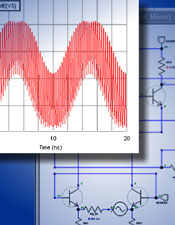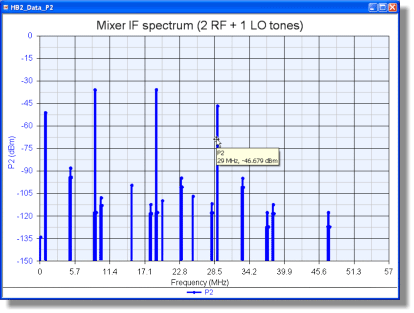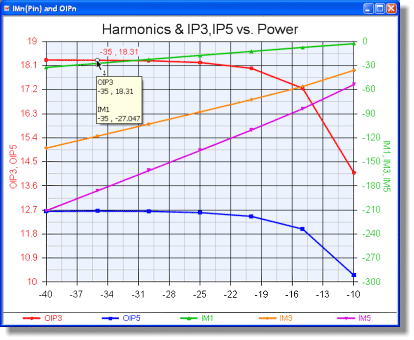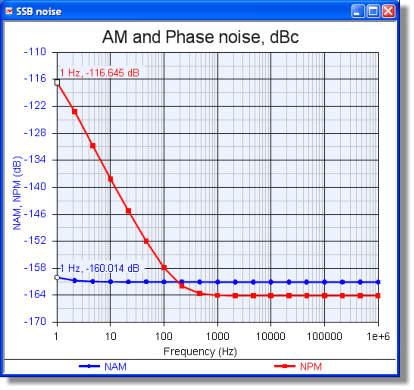What are you looking for?
Genesys Harbec (Harmonic Balance) Simulation

High Performance Nonlinear Active Circuit Design
Genesys Harbec is a frequency-domain nonlinear simulator based on the harmonic balance analysis technique. It is indispensable for the analysis and optimization of nonlinear circuits such as power amplifiers, mixers and oscillators. It calculates the DC and steady-state power, voltage and current spectrums at all nodes in a circuit. It is orders of magnitude faster than SPICE, and has higher dynamic range for analyzing nonlinear RF performance specs such as amplifier gain compression, third order intercept (TOI), mixer conversion gain and oscillator phase noise.
Nonlinear circuits in Genesys Harbec can be constructed from a combination of industry-standard SPICE or Verilog-A nonlinear device models, lumped components, accurate frequency-domain physical models, S-parameter measurements, and EM results.
Harbec also transcends the limitations of linear simulators, enabling robust designs that account for bias-dependence, harmonic distortion, and many other effects shown in the table below. When used with 1000's of nonlinear device models already in Genesys libraries, Harbec helps you predict and overcome nonlinear design challenges.
| Applications | Nonlinear effects | Typical steady-state measurements |
|---|---|---|
| Low Noise Ampfliers | Bias-dependence (battery life) | Voltage, current, power harmonics and spectrums |
| Power Amplifiers | Power-dependence (compression or starvation) | Steady-state waveforms Power added efficiency Compression curves Power contours Third Order Intercept (TOI) Harmonic distortion |
| Mixers | Temperature-dependence Frequency conversion |
DC current draw Conversion gain Conversion efficiency Conversion noise figure LO-RF-IF isolation Intermods Image rejection |
| Oscillators | Load-dependence Spectral purity Phase noise |
DC-to-RF Efficiency Oscillation frequency spectrum Phase noise spectrum |
| Receivers | Noise mixing and frequency translation | Saturated power Sensitivity Dynamic range Noise figure |
| Transmitters | Frequency translation | AM-to-PM Gain compression Efficiency |
| Detectors | Device biasing | Large-signal S11 |
| Frequency Multipliers | Frequency conversion | 2-tone distortion, IP3 Signal isolation |
| Active switches, attenuators, circulators | Device biasing | Conversion gain Signal isolation |
| Active bias compensation | Device biasing | Efficiency |

Learn more about Genesys Harbec
The Genesys Harbec (Harmonic Balance) Simulator is built for accuracy, convergence and speed. From real-time tuning, to application of intelligent convergence techniques, to electromagnetic co-simulation, Harbec adds complete DC and harmonic balance nonlinear simulation and optimization to the already powerful suite of synthesis, linear small-signal analysis, electromagnetic analysis, and physical design tools in Genesys.
What is Harmonic Balance?
Harmonic Balance obtained its name from a simulation technique where the computer iteratively adjusts the magnitude and phase of all harmonic signals flowing around in a circuit until they sum to zero at every node to obey Kirchoff’s current law. When this condition is achieved, you have obtained "harmonic balance" and the nonlinear circuit is solved.
The harmonic signals are the complex Fourier coefficients of signals in the circuit being represented in the frequency domain. For example, a square wave signal of 1 kHz will have many higher harmonics that are multiples of the fundamental 1 kHz tone. When these harmonics hit a nonlinear device such as a transistor, more harmonics of the fundamental tone are generated. The more nonlinear a circuit is, the more harmonics it contains, and therefore will require more memory and time to achieve "harmonic balance" in the solution process.
Complexity further increases when multiple fundamental tones are injected and frequency mixing occurs to generate even more harmonics for the simulator to achieve "harmonic balance" convergence. This is where advanced mathematical algorithms are developed to achieve the fastest convergence with the least amount of memory in Harbec.
Multi-Tone Harmonic Balance Nonlinear Analysis and Optimization
Designers can specify any number of fundamental tones for analysis. Limited only by memory and available time, an arbitrarily complex spectrum can be analyzed and optimized.



DC Analysis and Optimization
RF and wireless engineers need to know how a change in the DC bias voltage affects the response of their designs. With Harbec, you can tune the DC bias voltages and currents to instantly know how it affects the circuit's behavior. You can also use the optimization engine to help you figure out what DC voltages and currents will give you the best performance and efficiency.
Real-Time Tuning
Harbec has been optimized for high speed, which enables real-time tuning for many circuits. Designers quickly evaluate circuit sensitivities and make fine adjustments by just clicking the mouse or tapping the keyboard. Component vales are tuned and amplifier distortion graphs update in real-time. This simulation uses accurate EM results of passive matching structures.
Co-Simulation with Momentum GXF EM simulator
Engineers can simulate the non-linear performance of circuits with EM-accurate modeling of distributed components. For the first time, designers can co-simulate harmonic balance with electromagnetic simulation. This takes full advantage of the accuracy of EM simulation and the generality of non-linear simulation.
Using Genesys, EM and circuit co-simulation is nearly transparent. External EM ports are added to the layout and the simulation is run. Behind the scenes, Genesys automatically recognizes the lumped components, removes them, adds internal ports, and runs the EM simulation. Then, the multi-port data is transparently included in a circuit theory simulation. Once the initial design is complete, the lumped components can be interactively tuned or automatically optimized at high speed. Now, with the addition of Harbec, non-linear circuits with embedded lumped components are verified without cumbersome data transfer. Since all of the simulators are integrated into one environment, you can easily manage all data in a single workspace.
Nonlinear Performance Optimization with Intelligent Convergence
In addition to incorporating convenient features dedicated for practical applications, Harbec also includes the latest convergence technologies to ensure accurate, analysis with minimal memory requirements. Based on 1- and n-dimension FFTs and orthogonal APFTs, as well as direct methods for sparse systems and non-sparse systems, it converges quickly with minimum memory consumption and also excludes aliasing effects such as the noise of Fourier Transformations. Krylov sub-space methods are used to analyze large circuits with many frequencies when memory is limited.
The most important breakthrough in Harbec, however, was the application of adaptive intelligent convergence techniques to find and use the best convergence strategy amongst the many techniques available to solve nonlinear simulation problems. The software intelligently adjusts power supply levels, signal levels, number of spectral tones, or even device nonlinearities to obtain a converged solution. Harbec explores and learns the fastest solution approaches for solving the circuit and applies it for subsequent swept analysis and nonlinear optimization.
Automatic Nonlinear Device Linearization
To make it easy to simulate nonlinear and linear (S-parameters) components on the same schematic, Harbec runs a DC analysis on circuits and linearizes any nonlinear devices. The linear model is then used in S-parameter simulation. Now, you can adjust the bias to improve the S-parameter performance and you can study the statistical performance vs. bias. In addition to making the linear/nonlinear simulation easy, automatic linearization makes it easy to verify and optimize nonlinear model parameters to match measured S-parameters for nonlinear modeling applications.
Available Signals and Sources
To create real-world signals, a wide range of signals can be used to stimulate a circuit. The task of finding the fundamental frequencies for all frequencies of signal sources is completed by Harbec automatically. In addition to the standard single-frequency voltage, current, and power sources, Harbec includes pulse, periodic piecewise linear, and other user-defined sources.
Available Models
Harbec includes more than 6000 nonlinear models for parts from over 25 manufacturers. A large selection of discrete BJTs, MESFETs, MOSFETs, and diodes are available to the user. In addition to included RF and microwave devices, almost any SPICE model and Verilog-A model can be imported for nonlinear simulation with Harbec.
SPICE and Verilog-A Model Import
Long the industry standard of analog simulation, thousands of models and circuits have been developed using SPICE netlists or Verilog-A behavioral models. Harbec supports most SPICE elements and is able to use circuit netlists directly. This feature gives designers access to a wide range of circuit models available on the web and in literature.
How is Genesys Harbec Made Available?
Genesys Harbec is available in Genesys bundles containing the Circuit building blocks, namely:
- W1324BP Genesys Core, Synthesis, Circuit Bundle
- W1326BP Genesys Core, Synthesis, Circuit, System Bundle
- W1327BP Genesys Core, Synthesis, Circuit, EM Bundle
- W1328BP Genesys Core, Synthesis, Circuit, System, EM Bundle
- W1336BP Genesys Core, Synthesis, Circuit, System, Modulated RF Bundle
- W1338BP Genesys Core, Synthesis, Circuit, System, Modulated RF, EM Bundle
Return to the Genesys Product Structure & Options Summary.
